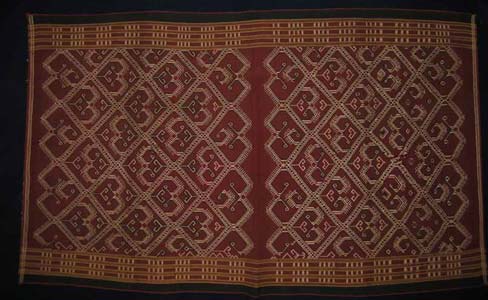
|
| home | site map | bibliographies | country | forum | links | studies | what's new | photogalleries | about us | |
|
 |
||
|
comparison of Iban (possibly Mualang) skirts |
|
| A discussion arose on the www.tribaltextiles.info/forum community on the similarities of design to be seen in certain skirts from Borneo although with the designs being executed in different techniques. Reference was made to further similarities with photos of Iban women shown in reference works on Borneo and the textiles worn by the ethnic groups there. In order to make comparison between the photos posted - which are scattered over three pages (to date) of posting - and the photos in the literature the photos have been taken and displayed horizontally below as they would be worn. | |
 |
The first skirt to be posted by Pamela Cross: "The design is embroidered
on what is, I believe, purchased, machine woven cloth, probably cotton
but could have some synthetic mixture. The coloured thread of the straight
lines of the embroidery seems to be silk in but could be mercerised cotton
in the natural coloured thread used for the chain stitch embroidery in
the all over curly designs." |
 |
The second skirt was posted by John Kreifeldt: "I have just been
offered this skirt which is very reminiscent of yours (Pamela's). The
dealer says the runner says it is Mualang. I had been looking for sungkit
examples from that region. The Mualang are an Ibanic people and seem to
have commonalities with the Kantu' and Ketunggau also of Kalimantan.The
dealer is also offering me others as well as a skirt done in pilih.
Sungkit looks identical on both sides except that the threads on one side have a very tiny slant as they move to the weft thread above. On the other side they are all horizontal. Difference is noticeable under close viewing. Pilih looks "reversed" on the two sides. The supplementary thread floats on one side. Sometimes the tread floats long distances on one side making in a onesided design. " |
 |
The third skirt was also posted by John: "sungkit skirt from the Mualang people of Borneo. a variation of Pamela's originally posted design" |
| After the post of the first photo by
Pamela, John subsequent referred us to "a skirt with the identical
motif in Edric Ong's book "PUA". It is pictured as Bidang
1 (on page 67) in his book. Since the rest of his title has "Sarawak"
in it, I assume his bidang is from Sarawak as well. He is not more specific
as to location however. The designs are the same but embroidered a bit
differently". Eric Ong describes the design as: 'A simple lozenge
motif incorporating a fern tendril design that is repeated diagonally
and in two basic colours - brown and black. The central panel woven
in a 'brocade' technique exposing more weft. The top and bottom ikat
borders separately woven and stiched on to the central panel. - Three
bands consisting of 2 way lines and middle fern motif in earthy brown
colour. 42" x 20".' |
|
For those of you who have the relevant
literature John suggests that the design is shown: "The 1912 book
by Hose and McDougall - The Pagan Tribes of Borneo -has this same design
on a skirt worn by a woman. FIGURE 106. Iban Women dancing with human
Heads page 188." Susan Stem has pointed out to me that this same
photo, although reversed, is shown on page 52, Figure 22 in Gittinger's
Splendid Symbols. |
|
Susan Stem is suggesting that the design
may be appearing again: "I found another Iban skirt with similar
'hook' motifs as Pamela's, but not in the lattice pattern of John's:
in Gittinger's Splendid Symbols, p.212. It appears to possibly be sungkit
also". |
|
|
| home
|
site map | bibliographies
| country | forum |
links | studies
|
what's new
| photogalleries | about
us | |
|
Copyright © 2012 Pamela A Cross. The contents of this site, including all images and text, are for personal, educational, non-commercial use only and may not be reproduced in any form without the express permission of Pamela A Cross. |
|
If
you have any comments
on the tribaltextiles.info website please send them to us. If you have
any general tribal textile comments or questions go to the tribaltextiles.info/community
forum to share your thoughts and questions with an international
community of enthusiasts. |
this
page last updated
13 September, 2004
|